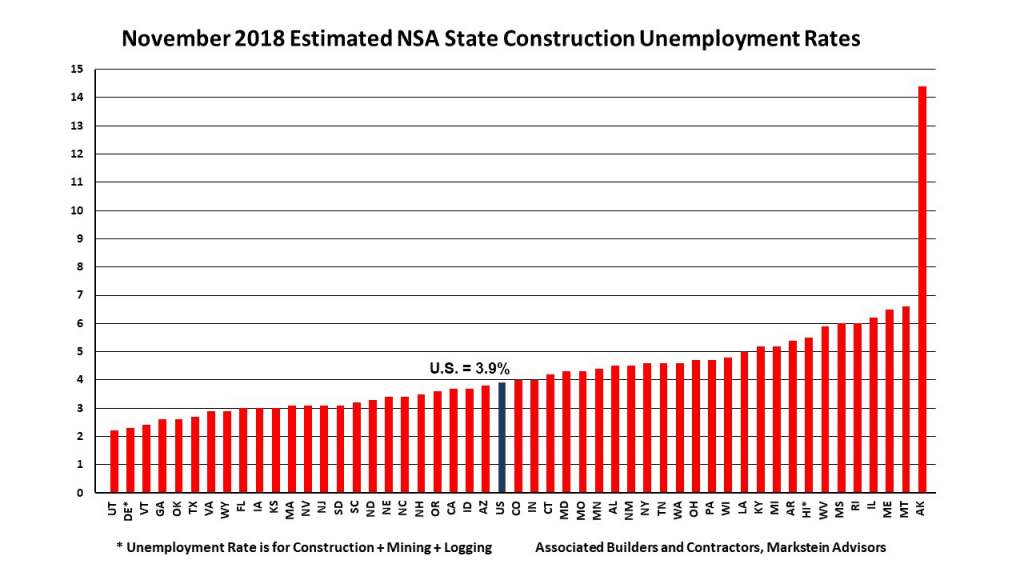
November Construction Unemployment Rates Down in 44 States Year Over Year, Says ABC
Estimated November construction unemployment rates fell nationally and in 44 states on a year-over-year basis, according to an analysis of U.S. Bureau of Labor Statistics data released today by Associated Builders and Contractors.
As the November 2018 not seasonally adjusted national construction unemployment rate fell 1.1 percent from a year ago to 3.9 percent, the construction industry employed 277,000 more workers nationally compared to November 2017, according to BLS statistics.
“Even as much of the nation moved into its annual cold weather slowdown, employment of construction workers continued to be fairly strong,” said Bernard M. Markstein, Ph.D., president and chief economist of Markstein Advisors, who conducted the analysis for ABC. “Unemployment rates were lower compared to a year ago in 44 states, higher in five states and unchanged in one, Idaho. The country and 32 states posted their lowest November construction unemployment rates on record. Further, this is the first November on record when all state unemployment rates except for Alaska’s were below seven percent.”
Because these industry-specific rates are not seasonally adjusted, national and state-level unemployment rates are best evaluated on a year-over-year basis. The monthly movement of the rates still provides some information, although extra care must be used in drawing conclusions from these variations.
The national NSA construction unemployment rate from October to November rose 0.3 percent. Thirty-four states posted higher estimated construction unemployment rates; 15 states were down from October and one, Arkansas, was unchanged.
The Top Five States
The states with the lowest estimated NSA construction unemployment rates in order from lowest to highest were:
1. Utah, 2.2 percent
2. Delaware, 2.3 percent
3. Vermont, 2.4 percent
4. Georgia and Oklahoma (tied), 2.6 percent
Utah and Vermont were also in the top five in October. Utah had the lowest construction unemployment rate in November, up from second lowest in October.
Delaware had the second lowest rate in November, an improvement from the 14th lowest rate in October, and the state’s lowest November construction unemployment rate on record. Note that Delaware’s unemployment rate is a rate for construction, mining and logging combined. The data to estimate a construction unemployment rate alone are not available for neither Delaware nor Hawaii.
For the second month in a row, Vermont had the third lowest rate in November. This was the state’s lowest November construction unemployment rate on record.
Georgia and Oklahoma tied for the fourth lowest rate in November, the lowest on record for both states for the month. For Georgia, that was up from seventh lowest in October (tied with Texas). For Oklahoma, it was an improvement from the 28th lowest rate. Oklahoma also posted the largest monthly decline—down 1.1 percent—and the fourth largest year-over-year drop—down 2.5 percent (tied with North Dakota).
Iowa, which had the lowest rate in October, fell to ninth lowest in November with a 3 percent rate (tied with Florida). Nevertheless, it was the state’s lowest November rate on record.
North Dakota, which tied with Vermont and Wyoming for the third lowest construction unemployment rate in October, dropped to 17th lowest in November with a rate of 3.3 percent. This was still the state’s second lowest November rate on record behind the 2.5 percent rate in 2015.
Meanwhile, Wyoming slipped to seventh lowest in November with a 2.9 percent rate, tied with Virginia. It was the state’s lowest November rate since 2007, when it was 2.6 percent rate, and the second largest year-over-year decrease in the nation, down 3.5 percent.
The Bottom Five States
The states with the highest estimated NSA construction unemployment rates in order from lowest to highest were:
45. Mississippi and Rhode Island (tied), 6 percent
47. Illinois, 6.2 percent
48. Maine, 6.5 percent
49. Montana, 6.6 percent
50. Alaska, 14.4 percent
Alaska and Mississippi were also in the bottom five in October. For the fourth month in a row, Alaska had the highest estimated construction unemployment rate. Nonetheless, this was the state’s lowest November rate on record, matching its 2015 rate.
Montana had the second highest rate compared to ninth highest in October (tied with Tennessee). Its 3.2 percent year-over-year drop was the third largest decrease among the states. Also, it was the state’s lowest November rate since 2007, when it was 4.2 percent.
Maine had the third highest rate in November compared to sixth highest in October (tied with Connecticut and Illinois).
Illinois had the fourth highest rate in November compared to sixth highest in October (tied with Connecticut and Maine). Still, this was the state’s lowest November construction unemployment rate on record.
Mississippi and Rhode Island tied for the fifth highest rate in November. For Mississippi this was an improvement from second highest in October. It was the state’s lowest November rate on record and the third largest monthly decrease in the nation, down 0.9 percent. For Rhode Island, that compared to 17th highest in October, tied with Ohio. This was the state’s second lowest November rate since the construction unemployment rate reached 5.1 percent in 2004, behind a rate of 5.9 percent in 2017.
Kentucky, which had the third highest rate in October, improved to 10th highest in November with a 5.2 percent rate, tied with Michigan. Also, this was Kentucky’s lowest November construction unemployment rate on record.
Arkansas and West Virginia, which tied for the fourth highest rate in October based on revised data (originally reported as third and eighth highest, respectively), improved to ninth and seventh highest, respectively, with rates of 5.4 percent and 5.9 percent rate. For both states, it was their lowest November construction unemployment rate on record.
To better understand the basis for calculating unemployment rates and what they measure, see the article Background on State Construction Unemployment Rates.






